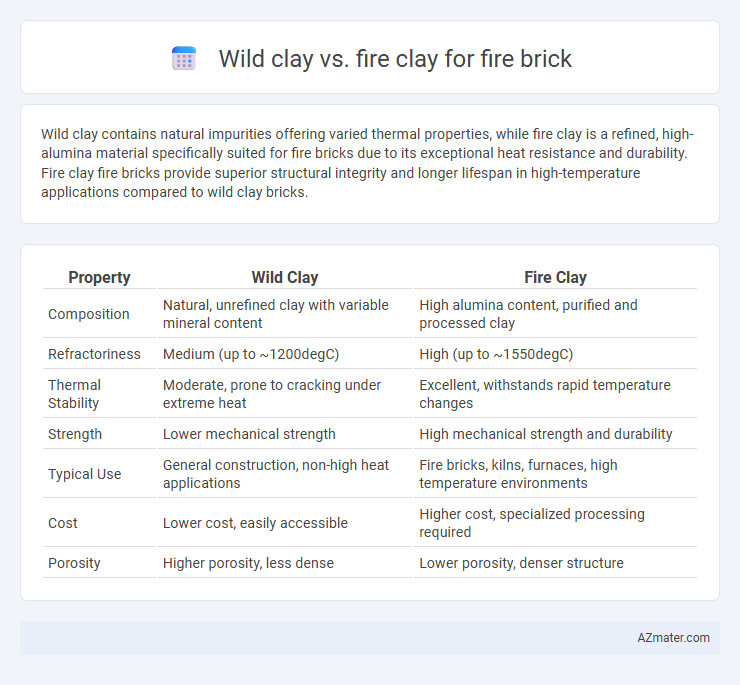Wild clay contains natural impurities offering varied thermal properties, while fire clay is a refined, high-alumina material specifically suited for fire bricks due to its exceptional heat resistance and durability. Fire clay fire bricks provide superior structural integrity and longer lifespan in high-temperature applications compared to wild clay bricks.
Table of Comparison
| Property | Wild Clay | Fire Clay |
|---|---|---|
| Composition | Natural, unrefined clay with variable mineral content | High alumina content, purified and processed clay |
| Refractoriness | Medium (up to ~1200degC) | High (up to ~1550degC) |
| Thermal Stability | Moderate, prone to cracking under extreme heat | Excellent, withstands rapid temperature changes |
| Strength | Lower mechanical strength | High mechanical strength and durability |
| Typical Use | General construction, non-high heat applications | Fire bricks, kilns, furnaces, high temperature environments |
| Cost | Lower cost, easily accessible | Higher cost, specialized processing required |
| Porosity | Higher porosity, less dense | Lower porosity, denser structure |
Introduction to Wild Clay and Fire Clay
Wild clay, often sourced directly from natural deposits without significant processing, contains varied mineral compositions that influence its heat resistance and durability in fire brick applications. Fire clay, a refractory material primarily composed of hydrous aluminum silicates, provides superior thermal stability and strength, making it ideal for high-temperature environments. Understanding the distinct mineralogy and firing properties of wild clay versus fire clay is crucial for optimizing fire brick performance in industrial furnaces and kilns.
What is Wild Clay?
Wild clay is a natural, unrefined clay source found in various geographical locations, often characterized by its variable mineral content and organic matter presence, which impacts its suitability for fire brick production. Fire clay, in contrast, is a specific, processed type of clay that possesses high alumina and silica content, offering superior refractoriness and thermal stability necessary for manufacturing durable fire bricks. Understanding the mineral composition and thermal properties of wild clay is essential before using it as a fire brick material to ensure it meets the high-temperature resistance standards required in industrial applications.
What is Fire Clay?
Fire clay, a key component in fire bricks, consists of natural clay material rich in alumina and silica, known for its high heat resistance and durability. Wild clay refers to unprocessed, naturally occurring clay deposits that may contain impurities affecting performance at elevated temperatures. Fire clay is specifically mined and refined to ensure optimal thermal stability and strength, making it the preferred choice for manufacturing fire bricks used in furnaces, kilns, and fireplaces.
Key Differences Between Wild Clay and Fire Clay
Wild clay and fire clay differ primarily in their mineral composition and thermal properties, with wild clay containing higher impurities and varying silica content compared to the purer, kaolinite-rich fire clay. Fire clay exhibits superior heat resistance and thermal stability, making it ideal for manufacturing refractory fire bricks used in high-temperature environments such as kilns and furnaces. Wild clay's inconsistent composition results in lower refractoriness and mechanical strength, limiting its suitability for industrial fire brick applications.
Physical Properties Comparison
Wild clay typically offers higher plasticity, allowing easier molding and shaping for fire brick production, while fire clay contains more refractory minerals, enhancing thermal resistance and durability. Fire clay exhibits superior thermal stability, with melting points often exceeding 1,750degC, compared to wild clay's lower firing temperature range. The density of fire clay fire bricks generally surpasses that of wild clay bricks, resulting in enhanced strength and resistance to thermal shock during high-temperature applications.
Heat Resistance and Performance
Fire clay bricks exhibit superior heat resistance, typically withstanding temperatures up to 1,400degC, making them ideal for high-temperature industrial applications. Wild clay bricks, while more abundant and affordable, generally have lower heat resistance, around 1,100degC, resulting in reduced durability under intense thermal stress. Performance-wise, fire clay bricks offer enhanced thermal stability and structural integrity, ensuring longer service life in furnaces and kilns compared to wild clay bricks.
Workability in Brickmaking
Wild clay often contains higher impurities and variable particle sizes, making workability inconsistent and requiring more adjustments during brickmaking. Fire clay exhibits uniform particle distribution with higher plasticity, enhancing moldability and ease of shaping fire bricks with precise dimensions. Consistent workability of fire clay reduces manufacturing defects and improves the final structural integrity of fire bricks in high-temperature applications.
Pros and Cons of Wild Clay Bricks
Wild clay bricks, often sourced locally with minimal processing, offer cost-effective and eco-friendly fire brick options due to their natural mineral composition. Their inconsistent chemical makeup can lead to lower thermal resistance and susceptibility to cracking under high heat compared to fire clay bricks, which are specifically engineered for high temperature durability. Wild clay bricks provide good insulation but lack the structural strength and longevity of fire clay bricks, making them suitable for less demanding kiln or fireplace applications.
Pros and Cons of Fire Clay Bricks
Fire clay bricks offer excellent heat resistance and durability, making them ideal for high-temperature applications like furnaces and fireplaces. Their high alumina content provides superior thermal shock resistance compared to wild clay bricks, but they tend to be more expensive and less readily available. Fire clay bricks can withstand repeated heating and cooling cycles without cracking, although they may be heavier and less porous than alternative materials.
Which Clay is Best for Fire Bricks?
Fire clay is the best choice for fire bricks due to its high alumina content, typically between 30% and 40%, which provides superior heat resistance and durability at temperatures exceeding 1500degC. Wild clay contains lower alumina and higher impurities, making it less stable under extreme thermal conditions and prone to cracking. Fire bricks made from fire clay exhibit better thermal shock resistance and longer lifespan in industrial kilns and furnaces.

Infographic: Wild clay vs Fire clay for Fire brick
 azmater.com
azmater.com